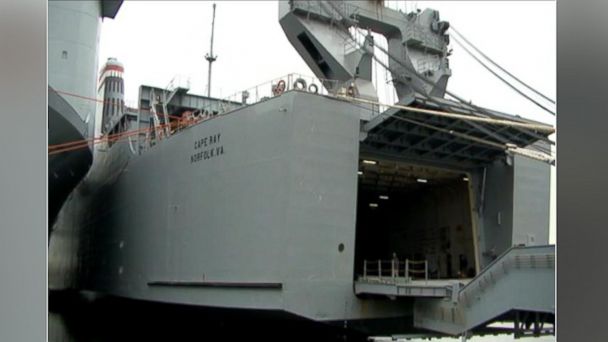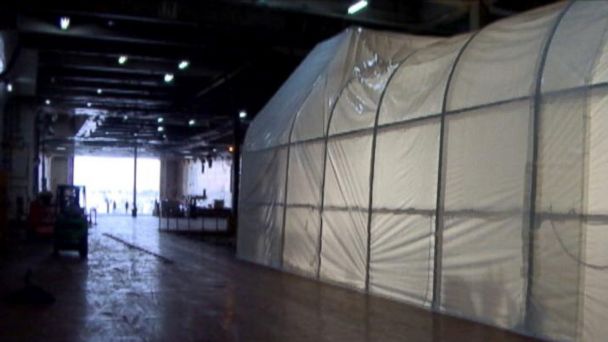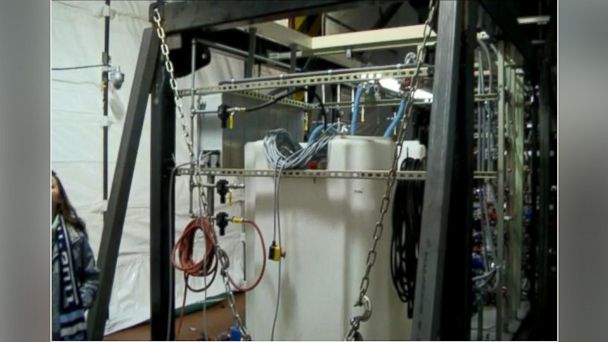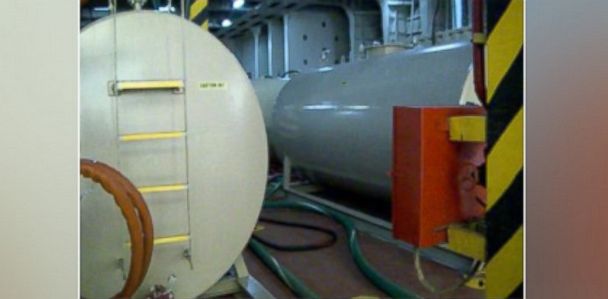A Look at the Massive Ship That Will Destroy Syria's Chemical Weapons

The MV Cape Ray, docked in Portsmouth, Va., will destroy Syria's most dangerous chemical weapons at sea. Image credit: Chris Good/ABC News
To neutralize the most dangerous chemicals stockpiled by Syria in a weapons program that brought global attention to a violent civil war, the international community will rely on a massive ship currently docked in Portsmouth, Va.: the MV (motor vessel) Cape Ray, a transport and humanitarian-response vessel owned by the U.S. Maritime Administration.
The plan, announced in November by the Organization for the Prohibition of Chemical Weapons (OPCW) and agreed to by Syria, calls for President Bashar al-Assad's regime to move Syria's most dangerous chemical-weapons components - already mixed mustard gas in liquid form, and a precursor to sarin gas - to the port of Latakia and out of the country, onto Norwegian and Danish ships. That process is behind schedule due to fighting in Syria.
Italy has offered to host the transfer of chemical components to the Cape Ray at one of its ports, but the details have not been worked out. The OPCW has set a goal of March 31 for the destruction of these chemicals, and June 30 for all of Syria's chemicals.

A tent, ventilated through carbon filters, houses the two chemical-weapons-destruction systems aboard the Cape Ray's main deck. Image credit: Chris Good/ABC News
The Cape Ray is part of a reserve fleet that helps surge military equipment into war zones when needed. The Cape Ray has deployed tanks, humvees, helicopters, and other vehicles to Iraq multiple times. It conducts humanitarian response to natural disasters and has responded to Haiti's earthquake, and hurricanes Katrina, Rita and Sandy.
It is about 650 feet long, has five decks, and will carry 35 sailors to operate the ship, plus 64 technical crew involved with the chemical destruction (a "handful" of whom will actually handle the chemicals and operate the machinery to destroy them, according to the top engineer), and an unknown number of U.S. military personnel.

One of two Field Deployable Hydrolysis Systems, developed in 2013 for this specific mission, that will destroy Syria's chemical weapons aboard the Cape Ray. Image credit: Chris Good/ABC News
It's currently being outfitted with two Field-Deployable Hydrolysis Systems (FDHS), which the Pentagon began procuring in February 2013, knowing it might need a way to destroy Syrian chemical-weapons components in the field. It did not expect to do so at sea, and the equipment had to be tested for vibrations, the sloshing of liquids, and other potential problems.
"Putting these systems on a ship wasn't the first thing that came to mind," Under Secretary of Defense for Acquisitions, Technology, and Logistics Frank Kendall said.
The two units are 20 feet by eight feet by eight feet - the size of a standard shipping container - and are being housed in the ship's main deck in a divided white tent about 60 feet by 36 feet. They cost $5 million apiece and were paid for through Department of Defense threat-reduction contingency funds, after Congress was notified.

Tanks like this one will hold dangerous chemicals and, separately, water, which will be pumped into the Field Deployable Hydrolysis Systems on the Cape Ray's main deck. Image credit: Chris Good/ABC News
The technology has been around - the U.S. has destroyed its own chemical weapons using a similar process for decades - but it has never been built in such a small, transportable unit, and chemical weapons have never before been destroyed at sea, to the knowledge of Rob Malone, an environmental engineer with Department of Defense and a top engineer on this project.
"This is not new technology. This is not a high-risk thing that we are doing," Kendall said.
Workers handling the chemicals will wear fully enclosed hazmat suits with oxygen supplied through a mask - described as "scuba suits" by Malone.
Seven hundred metric tons of Syria's most dangerous chemical-weapons components will be loaded onto the Cape Ray and destroyed over a 90-day mission, with the two FDHS units running continuously. Syria's chemicals will be stored on decks above and below the main deck where they're being destroyed.
The result of this destruction will be 1.5 million gallons of hazardous waste, which a top engineer likened to Drano, that will not be usable for chemical-weapons production, but nonetheless will need to be disposed of at a waste facility of some kind. (Details of disposal have not been worked out yet.)
If a spill were to occur, it would be contained to the ship's main deck, Malone said. The tents will be ventilated through carbon before exhaust is released from the ship, and those filters would, according to Malone, neutralize any chemical vapors in the event of a spill.
The Cape Ray is docked at a private shipyard in Portsmouth, alongside two other Maritime Administration vessels, and is expected to deploy within the next two weeks, Kendall said. The ship's captain, Rick Jordan, said he has not yet received orders for departure, where the chemicals will be transferred aboard, or where at sea they're to be destroyed.